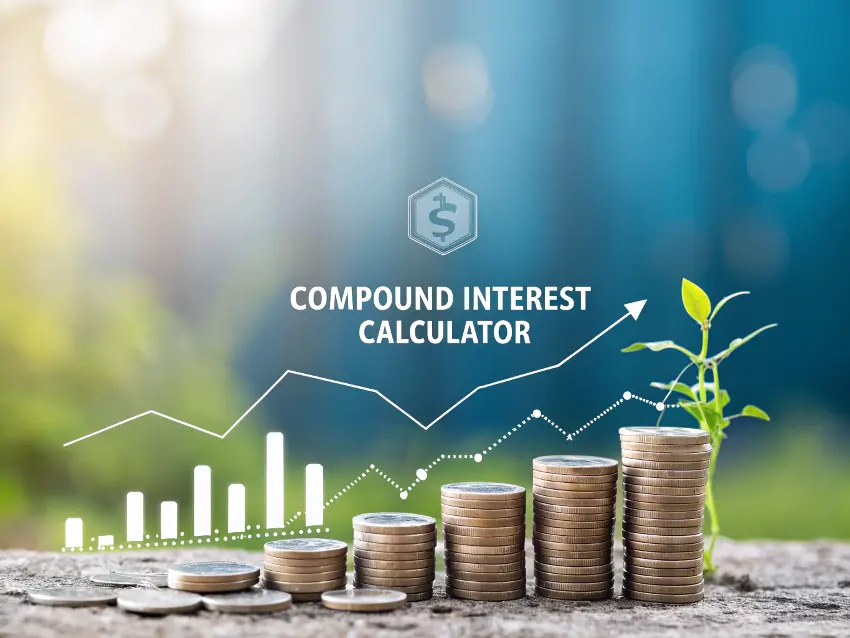Compound Interest Calculator
See how your money can grow with the power of compound interest

Compound Interest
Formula:
A = P(1 + r/n)nt + PMT((1 + r/n)nt - 1)/(r/n)
Where:
- A = Final amount
- P = Principal (initial investment)
- r = Annual interest rate (decimal)
- n = Compounding frequency per year
- t = Time in years
- PMT = Regular contribution amount
Compound interest is the addition of interest to the principal sum of a loan or deposit, or in other words, interest on interest.
It's one of the most powerful forces in finance, allowing investments to grow exponentially over time.
$
$
%
years
Result
$0.00
Total Contributions:
$0.00
Interest Earned:
$0.00
Growth Projection
How Compound Interest Works
Step 1: Initial Investment
Start with your principal amount (P). This is the initial money you invest.
Step 2: Interest Accrual
At the end of each compounding period, interest is calculated on your current balance. The interest rate depends on your annual interest rate divided by the number of compounding periods per year.
Step 3: Reinvestment
The interest earned is added to your principal. This new, larger amount becomes the basis for calculating interest in the next period.
Step 4: Regular Contributions
If you make additional deposits, these are added to your balance and also begin earning compound interest.
Step 5: Exponential Growth
Over time, as your principal grows, so does the interest you earn each period. This creates an accelerating growth curve—the power of compound interest.
Example Calculation
Let's say you invest $10,000 with an annual interest rate of 5%, compounded monthly, for 10 years:
Initial Investment (P): $10,000
Annual Rate (r): 5% or 0.05
Compounding Frequency (n): 12 times per year
Time (t): 10 years
Step 1: Find the rate per period: 0.05 ÷ 12 = 0.00417
Step 2: Calculate the number of periods: 12 × 10 = 120
Step 3: Calculate using the formula: A = P(1 + r/n)nt
Step 4: A = $10,000 × (1 + 0.00417)120
Final Amount: $16,470.09
Interest Earned: $6,470.09
Practical Applications
Retirement Planning
Use compound interest to project how your retirement accounts like 401(k)s and IRAs will grow over decades of saving.
College Savings
Project how education funds like 529 plans can grow to cover future college expenses for your children.
Saving for Major Purchases
Calculate how much you need to save regularly to afford a home down payment or other major expense in the future.
Emergency Fund Growth
See how your emergency fund can grow over time when placed in an interest-bearing account.
Frequently Asked Questions
What's the difference between simple and compound interest?
Simple interest is calculated only on the original principal amount, while compound interest is calculated on both the principal and the accumulated interest from previous periods. Over time, compound interest results in significantly higher returns than simple interest.
How does compounding frequency affect my returns?
The more frequently interest is compounded, the more your money will grow. For example, money compounded daily will grow more than money compounded annually, assuming the same annual interest rate. However, the difference becomes less significant as the compounding frequency increases.
What is the Rule of 72?
The Rule of 72 is a simple way to estimate how long it will take for your money to double at a given interest rate. Divide 72 by the annual interest rate (as a whole number) to get the approximate number of years. For example, at 8% interest, your money would double in about 72 ÷ 8 = 9 years.
How does inflation affect compound interest?
While your money grows with compound interest, its purchasing power may be reduced by inflation. To calculate your real return, subtract the inflation rate from your interest rate. For example, if you earn 7% but inflation is 3%, your real return is approximately 4%.
Important Notes
- This calculator provides estimates only and does not account for taxes, fees, or varying interest rates over time.
- Past performance is not indicative of future results. Actual investment returns will fluctuate and may differ significantly from constant returns shown here.
- Consider consulting with a financial advisor for personalized investment advice based on your specific situation.
Related Calculators
Explore more calculators to solve your calculation needs



